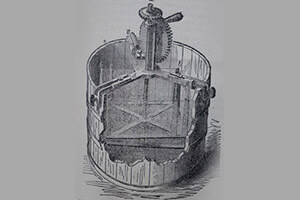Archived Columns
An Early History of the Honey Extractor in America

Before the honey extractor became well known, consumers purchased honey in the comb, the traditional way to buy honey. To the consumers of the late 1800’s when liquid honey from extractors was available, honey in the comb was the mark of purity, put in the comb and sealed up by the bees. That was protection against adulteration, liquid honey diluted with cheap sugars and other unknowns meant to increase its volume. Some unscrupulous vendors were bent on wringing the most money from every diluted drop of once pure honey. Honest beekeepers selling liquid honey from their extractors, as a new technology, had to contend with this difficulty until laws preventing the adulteration were enacted. Meanwhile beekeepers had the benefit of using the honey extractor, which permitted reusing their combs.
Major Franz Elder von Hruschka invented the honey extractor in the winter of 1864/1865. He was born in Vienna and resided near Venice.1 As for the spark of insight pointing to the centrifugal (spinning) principle leading to the separation of comb and liquid honey, one story circulated for decades, although its authenticity lay in doubt. Pellett2, apparently a doubter, reported the insightful moment as:
It was in 1865 that Major Hruschka…gave his small son a piece of honey on a plate. Placing the honey in a basket, the boy swung the basket around his head as children commonly do when carrying any kind of object. When Hruschka saw the honey was thrown from the comb by the motion, the idea of the extractor was born. Such is the story commonly told, although historians question the facts. They say the extractor was born of a long search for a way to remove the honey.2
Or perhaps the idea for the invention did not come from a long heroic search, but rather a fortunate change in one’s surroundings along with inspiration from another device, which was for molasses.
Crane relates the emergence of the extractor idea as:
Major Franz Elder von Hruschka… lived near… where a sugar factory had recently introduced ‘a centrifugal contrivance to separate liquid molasses from sugar that had already crystallized out’. Hruschka used a centrifuge in an attempt to separate liquid honey from crystallized (granulated) honey; he wanted to sell the latter as a sugar substitute, since sugar fetched a higher price than honey. This attempt came to nothing, but it gave him the idea of spinning combs to fling the honey out of them by centrifugal force.
Now step back to January 1, 1861, when the American Bee Journal began publication. This date marked the winter before the outbreak of the American Civil War coming in April with the firing on Fort Sumpter, South Carolina. In Philadelphia, the first home of the American Bee Journal, publication began in those tumultuous times.
Samuel Wagner, a bank cashier, and the American Bee Journal’s first editor, suspended publication upon finishing volume one while war raged on between the states. Still the American Bee Journal had made its mark as the first bee magazine in the English language, if only briefly.
In the winter of 1864/1865 while America struggled towards the close of the Civil War to end that spring, Major Hruschka made an early model of a device…


